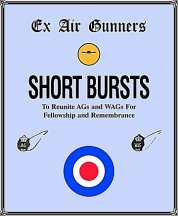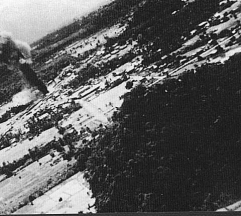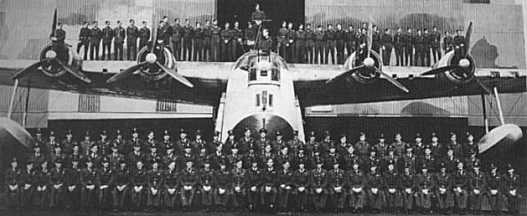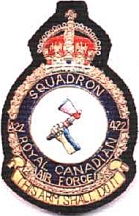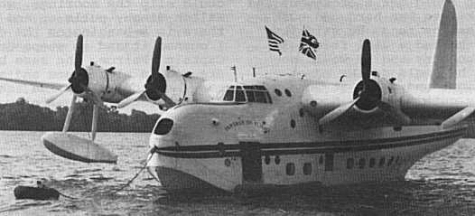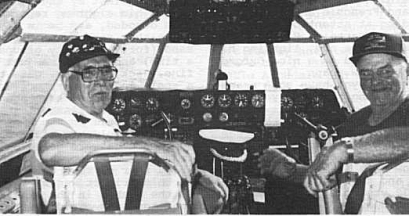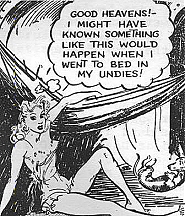BRANCH
REPORTS
Northern Saskatchewan Branch
On the 19th of July 19 Members of the Ex A/G &
WAGs Association gathered for their monthly brunch at the RCAF Association
Lynx Wing.
Treasurer Doug Warren reported that our finances were
in excellent shape.
C.R. Robson was the winner of the 50/50 draw.
Mac Smith submitted a story and a photo for the Web
Site. (See below)
Renee Andersen and his wife were in attendance and
Renee told of their visit to Trenton to see the Halifax bomber which is
in the process of being restored.
Ted Slocombe outlined several ways the Lynz Wing can
be supported.
“Smokey” C.A. Robson – Pres.
M. R. "Mac" Smith
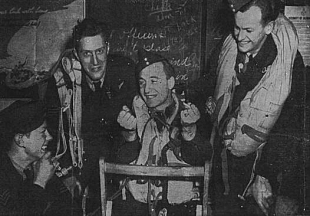 After a successful raid on Frankfurt 22 – 3 – 44, Sgt
Vern Irvine (third from left above) of Toronto was forced to throw his
huge four-engine bomber into a loop to evade a German fighter. The Nazi
fired at the Halifax from 800 yards and the rear Gunner, Sgt Mesmore “Sonny”
Rainville (second from left) of Montreal was tossed around so violently
he could not fire back.
After a successful raid on Frankfurt 22 – 3 – 44, Sgt
Vern Irvine (third from left above) of Toronto was forced to throw his
huge four-engine bomber into a loop to evade a German fighter. The Nazi
fired at the Halifax from 800 yards and the rear Gunner, Sgt Mesmore “Sonny”
Rainville (second from left) of Montreal was tossed around so violently
he could not fire back.
The Navigator, F/O Art Mauger (fourth from left) of
Victoria B.C. found himself and his instruments floating up to the roof.
The mid-upper Gunner, Sgt. M.R. “Mac” Smith (left) of Star City, Sask.,
stayed in his turret although afraid he might drop out of the “bubble”.
When the Halifax came out of the loop it found the
Night Fighter had disappeared, after missing all its shots. It was the
first operational flight for the crew together with the Alouette Squadron,
RCAF.
THE
SUNDERLAND FLYING BOAT
During World War 11 the Sunderland was truly a ubiquitous
aircraft. At various stages of the war Sunderland Squadrons operated out
of Greenland, Iceland, Shetland Islands, Northern Ireland, U. K., Gibraltar,
Malta, Crete, West and East Africa, Indian Ocean, Burma, and South Asia.
During the Korean conflict 88, 205, 209 Sunderland
Squadrons formed the Far East Flying Boat Wing with their main base at
Sebetar, Singapore, with rotation to Iwakubni.
Sunderland Squadrons 201 and 230 were active in the
Berlin Air Lift, Operation “Plainfare” flying shuttle service between Hamburg
and Berlin.
On operational trips Sunderland crews usually numbered
11 however, with the introduction of sophisticated sonar gear later in
the war, an extra WAG had to be carried. The crews consisted of 3 Pilots,
1 Navigator (3rd. pilot assisted the navigator), 2 Flight Engineers,
3 (or 4) WAGS, and 2 Air Gunners.
Because it was a flying boat, terms on the Sunderland
were nautical. It was not a fuselage, it was a hull. There was a bilge,
bulkheads, a bow and stern, upper and lower decks, ward room (complete
with table cloth and window curtains (until the CO saw them),. The cooking
area was referred to as the Galley, the toilet was the Head and the IAS
was in knots.
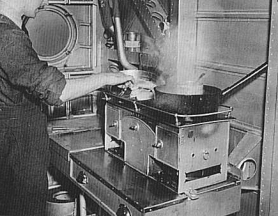
Cooking up eggs, bacon and beans in the galley
When the ship was on the water it was moored to a buoy.
To be placed in dry dock it was fitted with docking gear and hauled
up the slip. For boarding the crew took a dinghy from the dock to the aircraft
and, if the weather was unkind, flying gear was saturated with salt spray
before boarding for a 10 to 15 hour patrol. The crews had salt in their
veins.
Flying boats were similar to their land plane counterparts
when airborne. It was contact with the water which introduced radical differences
and similar to a sailing boat once the moorings were slipped. The only
way one could proceed was forward with no means of stopping and with limited
control over direction. The tendency was to weathercock into wind. Added
to these were the variations of wind, currents, tides, glassy water or
swells, restricted operating area e.g. shallows, other marine craft, markers,
buoys, debris, short flare paths, barrage balloons, and unlit shipping.
In air sea rescue work the Pilots had to master the
art of landing in troughs on high seas. WAGS struggled with ASV radar and
interpreting sonar signals (differentiating between schools of fish
and the oscilations of a sub’s propellers.) The Navigators plotted courses
over endless tracts of water. Engineers worried about fuel supply, and
the Air Gunners stared at white caps trying to spot a periscope wake, a
puff of smoke from a snorkel, or spot a life raft in the heavy swell.
The main task of the Sunderland crews was anti-shipping,
anti-submarine patrol, and air sea rescue. Early in the war Sunderland
Squadrons were used to evacuate VIP’s from Greece and Crete. In one case
72 refugees with luggage ands pets were evacuated in one Sunderland. In
South east Asia the Sunderland was used in low level bombing of enemy troop
trains and rail yards.
